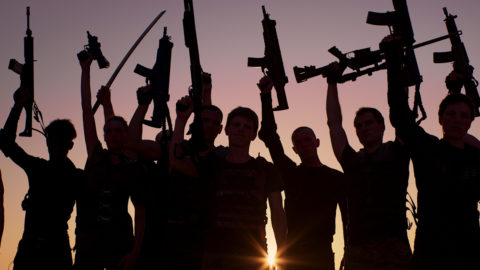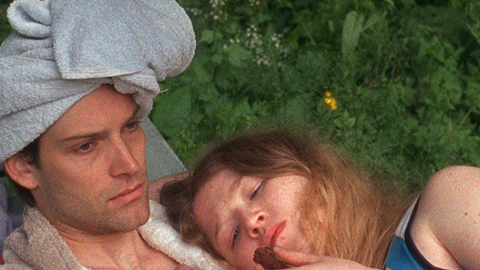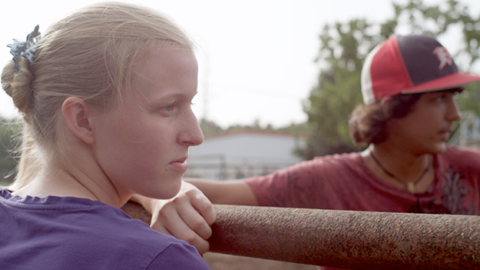Interview: Tyler Taormina
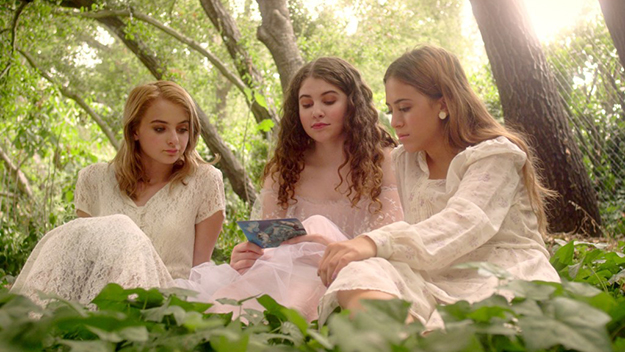
All images from Ham on Rye (Tyler Taormina, 2019)
Part coming-of-age film, part suburban fever dream, Tyler Taormina’s Ham on Rye is a charming and pleasantly strange amalgam of half-forgotten childhood memories. Reflecting an adolescence spent immersed in 1990s TV culture and a more recent engagement with the international art-house pantheon, Taormina’s shape-shifting debut performs a clever sleight of hand, coming on like a slightly surreal teen comedy in the vein of early Richard Linklater before segueing into something far stranger.
Told in two parts, the film descends on a sprawling group of high school students (all played by either first-time or unknown actors) on their way to Monty’s Deli for an annual right-of-passage gathering. Over sandwiches and soda, these alternately awkward and angelic boys and girls participate in odd volleys of coded come-ons. Like much in the film, these innocent moments mask more sinister undercurrents, which come to the fore as evening falls and the kids go their separate ways––some deeper into the night, others never to be seen again. In the film’s nocturnal second half, a neighborhood that once seemed enchanting now feels eerie and empty. In the most memorable scene, a few of the kids join a group of strung-out adults—played by assorted former child actors from ’90s Nickelodeon shows—for a moonlit bonfire, pointing toward one possible future for these impressionable teens.
Taormina, working with co-writer Eric Berger, displays a keen understanding of this milieu, drawing on his own experiences growing up in Long Island, as well as his background in music (he currently fronts the Los Angeles indie rock band Cloud) and developing kids’ television shows. Those two very different interests inform the 28-year-old filmmaker’s first feature in unique ways and help it stand apart from the typical teen angst parable. While Ham on Rye’s distinct halves may suggest a film of two minds, they simultaneously confirm a filmmaker with more on his mind than mere nostalgia.
In the days leading up to Ham on Rye’s international premiere at the 2019 Locarno Film Festival, where it competed in the Filmmakers of the Present program, Taormina and I corresponded about the making of the film: the autobiographical elements; establishing an emotional threshold through the story’s distinct two-part construction; working with an ensemble of unknown teen actors; and subtly integrating darker elements into the film without betraying the film’s tender heart. Ham on Rye next screens at the Sydney Underground and Deauville American film festivals.
One of the things admire about the film is that it implicitly deals with nostalgia without wallowing in it. I read that a friend of yours mentioned a sandwich shop as a place where teens would convene to hang out or hook up, and you sort of ran with that idea. I’m sure almost everyone had a place like that growing up. What was your Monty’s?
The film does stem from a joke made in passing. My eyes lit up and I was instantly immersed into this fictitious world. I was born and raised on Long Island, suburban wasteland of pizzerias, delicatessens, and bagel shops. My first film, a short called Wild Flies [2016], takes place at a pizzeria, and after Ham on Rye I have a few ideas involving bagel shops. I’m not entirely sure why this is… Nostalgia, yes, but I think I’m drawn to these places I’ve heard referred to as the “third place.” It’s not your house and it’s not where you work, but that other place where you can go to interface with the community. Seeing as systemic alienation is a theme of this film and a reality that weighs heavily on me, I guess it only makes sense to focus on centers where people will inadvertently commune. Growing up, we didn’t exactly have a “Monty’s” hangout spot but we did have endless strip mall parking lots where teenagers would meet up en masse. It was very exciting at first, a mild transgression.
There’s no town explicitly identified in Ham on Rye, although I know it was shot in Los Angeles. Can you talk about establishing this in-between, almost dreamlike sense of place?
It was very important for us to hide our Southern California backdrop as much as possible. We framed out red curbs, palm trees, and Cypress trees as much as possible but a few slipped in. I’ve driven across the country a few times and visited friends here and there. It’s shocking to me how many suburbs feel the same. I think about how my experience on Long Island is probably shared by people my age all around America, perhaps even in many other countries. There’s a modern homogeny that is in and of itself another layer of oppression. Transgression becomes even more unfathomable when an entire global generation seems to share the same path in gentrifying the cities. In this case, the transgression is, oddly enough, staying at home with your family—and it’s definitely not a “cool” one. This is a confusing taboo that weighs very heavily on me—in fact, I feel it may have in a way forced me away from home. Now, as a memory growing more distant every day, all that’s left is the dreamlike impressions of these places I’ve loved so much and then abandoned. They literally haunt my dreams.
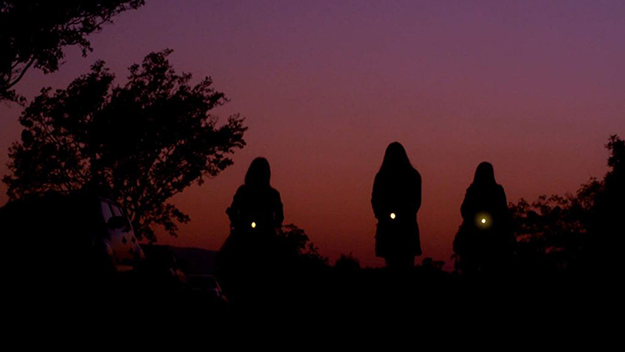
Could you walk me through the writing process? I’m curious about the structure of the film: there’s a distinct break in tone halfway through that signals something quite different for each of the characters, whether that be Haley, who wanders through various scenarios over the course of the night, or others who linger in the background for a bit but gradually disappear from the drama.
The starting point was the delicatessen. It became a great vessel of intrigue, a center of gravity in a way. At first, the only focus of the narrative was the gust of energy, like quicksand, that draws the community into the ritual at Monty’s. As a little kid I would dream of having braces that would make me look and feel older. Then as a teenager my friends and I would fantasize about all the cities we would live in after moving away. There was this force of excitement that slingshot us out of youth and into the unknown. The two-part narrative, I think, is an emulation of the heartbreak I experienced when I first realized that I was on the other side of that threshold. It was not an easy thing for me to grapple with and it just so happened to coincide with the emerging opioid epidemic, slowly making its way throughout Long Island. Ham was not conceived as a two-part narrative, but I think that coming upon this structure was inevitable.
There’s nothing that explicit about drugs in the film, but there is a kind of strung-out languor to the second half of the story––particularly in the bonfire scene, which features multiple characters in various states of consciousness––that could be said to approximate the feeling of a high, or at least a suspended state of reality. Can you expand on how these issues relate to the film and, by extension, the characters, as they cross into young adulthood?
We didn’t want to get too specific or didactic about the opioid crisis but perhaps provide a context for the environment that breeds it. Regarding the characters, there’s a scene in the film where Haley, the most recurrent character, sits by a crowded lake watching a variety of people around her. This environment bookends the narrative. In fact, the entire story takes place in-between the lighting of a fuse and the explosion of a firework set off at this lake. Within that time, Haley and her generation cross a threshold into a seemingly bleak adulthood. I wanted a multitude of disparate characters to orbit around her. I’m interested in large ensemble casts and the ability to create gradients within them. How will an assortment of people react to the same situation? The larger the cast, the more I’m able to fill in the spectrum: some are resilient, some are hopeful, some are numb, some are excited, et cetera. All of these possibilities surround Haley, she could become or “end up” any number of ways. When the firework goes off, it almost feels like it’s time for Haley to make a decision as to what path she’ll head down.
What was the casting process like? Most of the younger kids presumably haven’t acted in many films. Did you run into any problems when explaining certain rituals or references you were trying to work into the film, or were the kids open to the experimentation?
The casting process was fairly standard except for not having a casting director. We put out casting calls through several Los Angeles–based services and saw upwards of a thousand kids. The idea was simply that if I found vulnerability or charm in an actor, we would mold the script and the world to include them. The talent pool I imagine is a bit unique. Many of these kids had never acted in films before. One said his first curse word in our audition. Their naiveté was my fuel! I didn’t explain anything to them. Somehow they were wide open to the process. They were not allowed to read the script, only the pages that they appeared in. I was strategic about how much consciousness each character had regarding the mechanics of the world. In fact, the only character who was able to read the entire script was Sloan (played by Cole Devine), the gloomy twenty-something who works at Monty’s Deli. Being the only character in the second half who has not repressed the memory of the same suburban ritual from his time in high school, I was keen on having him in the know, bearing its weight.
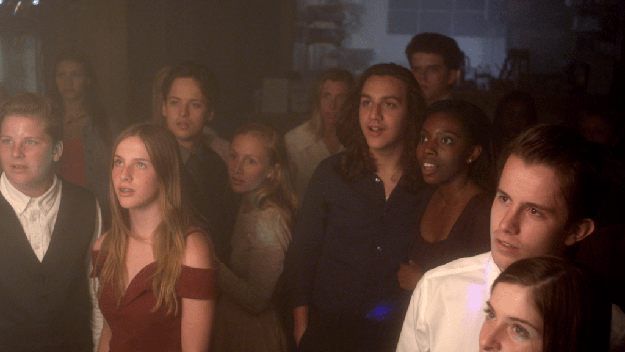
I’m curious about the film’s relationship with ’90s television. You’re not shy about hiding references to filmmakers like Richard Linklater and David Lynch––and, with regard to the bifurcated structure, even early Apichatpong Weerasethakul––but there’s also this parallel undercurrent of influences that seem rooted in the pop cultural iconography of your adolescence. Filling out the campfire scene with child actors like Danny Tamberelli from ’90s Nickelodeon shows, for example, is something that will likely be lost on anyone not of a certain generation. Was there a specific feeling you were hoping to evoke?
My work in film began in kids’ television. I started at the Tom Lynch Company where I developed shows such as Suburban Legends, a series I co-created with Kevin Anton. The show stars Haley Bodell, the “lead” of Ham on Rye, at the age of 12. Nineties Nickelodeon was my biggest influence for my first steps in moving images, especially programs like The Adventures of Pete & Pete and Hey Arnold!. Eventually, I stepped away from television and deep into cinema. Even still, Suburban Legends marks an incredibly meaningful time period in my life. I feel as though I can never access that same degree of purity and innocence ever again—another threshold crossed.
This frustration probably fuels a lot of the dissonant cultural juxtapositions in the film. I like the bonfire sequence in Ham as a nod to the poker game in Sunset Blvd., only my ’90s stars play Uno. I also enjoy this sequence because it feels like this backyard is where everybody in life eventually ends up after the wave of youth has crested and the “real world” settles in. I was keen on using talent who I personally have not seen in the limelight for a while––a few of them are still pretty active but I can be pretty oblivious to contemporary pop culture. Anyway, I wanted my generation to see them again and have the same experience as they might have scrolling on social media seeing faces they haven’t since graduation. You look at their faces and suddenly realize right there in the theater how much time has passed.
What was it like getting them on board? Was there any hesitation on their end to play off a collective memory of their own pasts? I’m also curious what it was like for them to see each other again.
Tom Lynch, who remained a mentor of mine, connected me with Danny Tamberelli [from The Adventures of Pete & Pete] and then the rest fell into place. He had been in the Nickelodeon shows All That and Figure It Out with Lori Beth Denberg, so I think she was excited to reunite with her old friend. Danny had also appeared in The Mighty Ducks with Aaron Schwartz years ago, so it became a really warm reunion despite the dark scene. They were all super cool about being involved in the film and had a good sense of humor about the meta context. I think Danny and Lori Beth are still friendly because they were really chummy on set, cracking jokes all night and singing Beat Happening between takes! It was fun and quite strange.
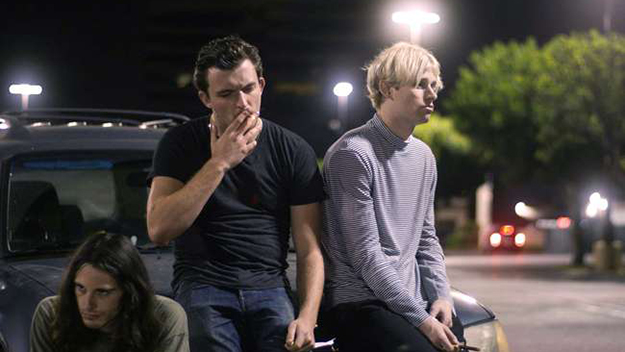
There’s a strong musical element to the film, both in terms of the instrumental cues and the use of pop songs. How did you conceive of the film from a sonic standpoint? And do you see a correspondence between these practices, artistically?
I do see a correspondence between my practice in music and film. Of the several bands I’ve been involved in, it’s always been a priority to construct each album as a whole to be listened straight through. We would approach these records narratively––not in the lyrics, but in the dynamics and the way one song would flow into the next. In my mind, every song has its own sense of space. I like to imagine the listener moving from room to room and I recognize this importance of space in my approach to making films. Even when there isn’t score or licensed music to guide the momentum there’s a rhythm presented in the cutting or in the sound design to sway along to.
The veteran German new age artist Deuter is credited with the music. Did you contribute any? Did you discuss how the film might correspond sonically to the story’s themes and structure?
I contributed some music to the film. David Croley Broyles (who has a small part in Ham and is also a member of my band Cloud), Jackson Wargo (of the band Snowball ii), and I got together for a few sessions in The Doughnut Shop, Jackson’s studio. We co-produced and mixed several tracks in the movie, the main one being “Hot Water,” which is essentially David’s tune. Jackson Wargo is an incredible engineer and producer, his work really helped elevate our soundtrack. Regarding licensed music, Deuter was a serendipitous marriage for the film. My co-writer Eric Berger was flying to Los Angeles to help me finish the script. Being an anxious flyer, he put on the airline’s spa channel music station. This is how he discovered “Pierrot.” He described the plane’s takeoff as “an ascension into heaven,” and said he was certain he was dying. When he told me this humorous story and showed me this song I said right then and there that this was the music of Ham on Rye. Much of the sequencing and even the writing was shaped around this piece of music. We’re very grateful to have it in the final cut of our film.
Before Locarno, Ham on Rye spent the year traveling to a handful of regional festivals in the U.S. What has it been like bringing your first feature out into the world? Is it finding the audience and platform you’d hoped?
Showing around the film has been pretty challenging for me. I made the movie in response to a series of compulsions, intuitions, things on my mind that I hadn’t fully understood. While showing it to our first test audiences and contacts I was so confused. It was such a long, personal effort for me, and now random people’s reactions were suddenly very important. This past February, the Santa Barbara International Film Festival was the first public screening of any film I’d ever made. I had no idea what to expect from the whole process. The initial U.S. festivals we played at resulted in a series of shrugs, walkouts, and polite words that you couldn’t be sure were genuine. Having said that, there were always one or two people who were moved by the film, although they seemed more like bizarre outliers. Luckily, these outliers championed the film and kept it circulating. The Maryland Film Festival is where everything changed. That’s where we first found our audience, and it really took us by surprise. At one festival you’ve made “the most walked-out film,” and another results in kind words from The New Yorker. It’s pretty painful, to be honest. I’m grateful that the film has found some momentum.
Jordan Cronk is a critic and programmer based in Los Angeles. He runs Acropolis Cinema, a screening series for experimental and undistributed films, and is co-director of the Locarno in Los Angeles film festival.



